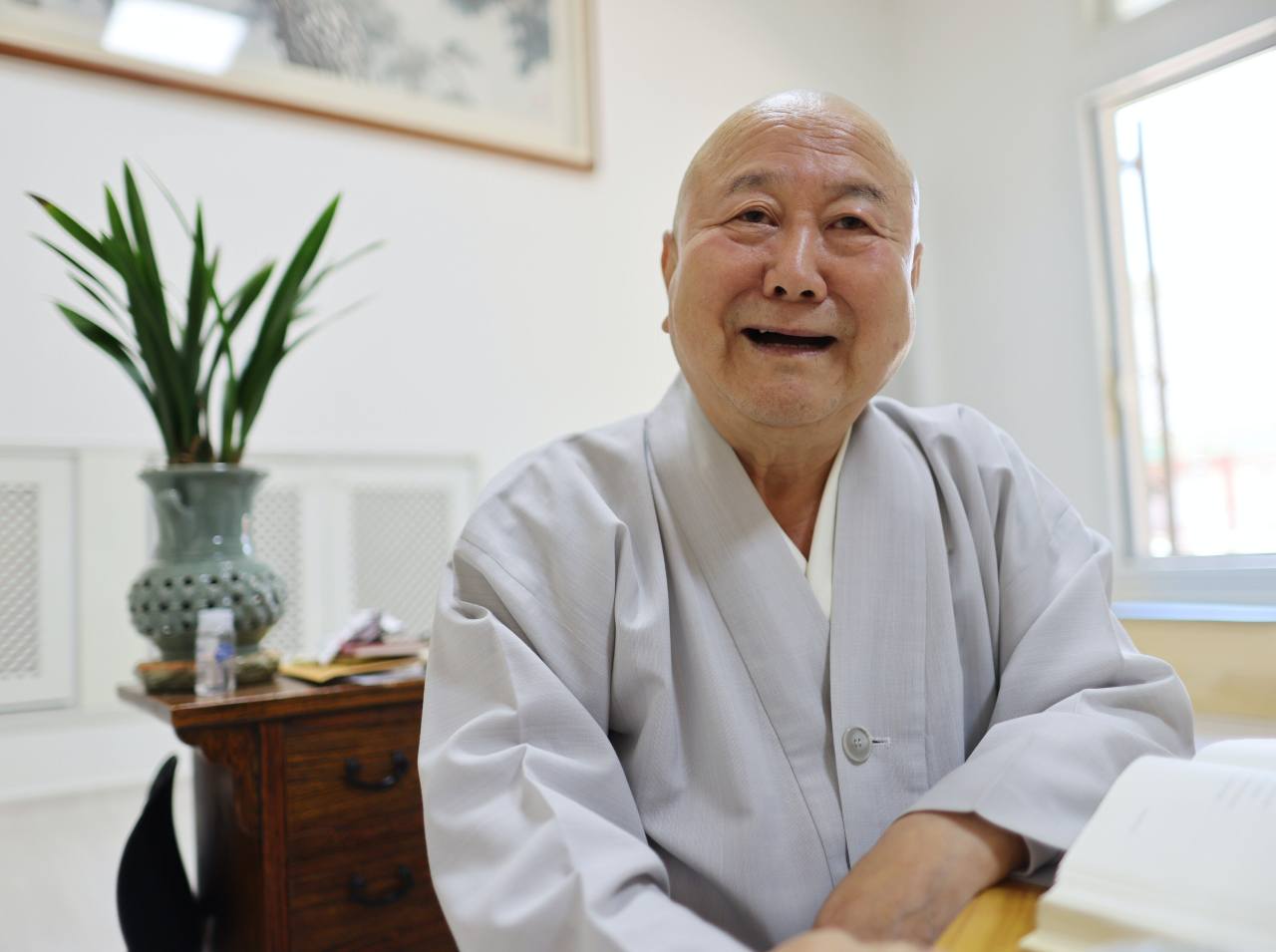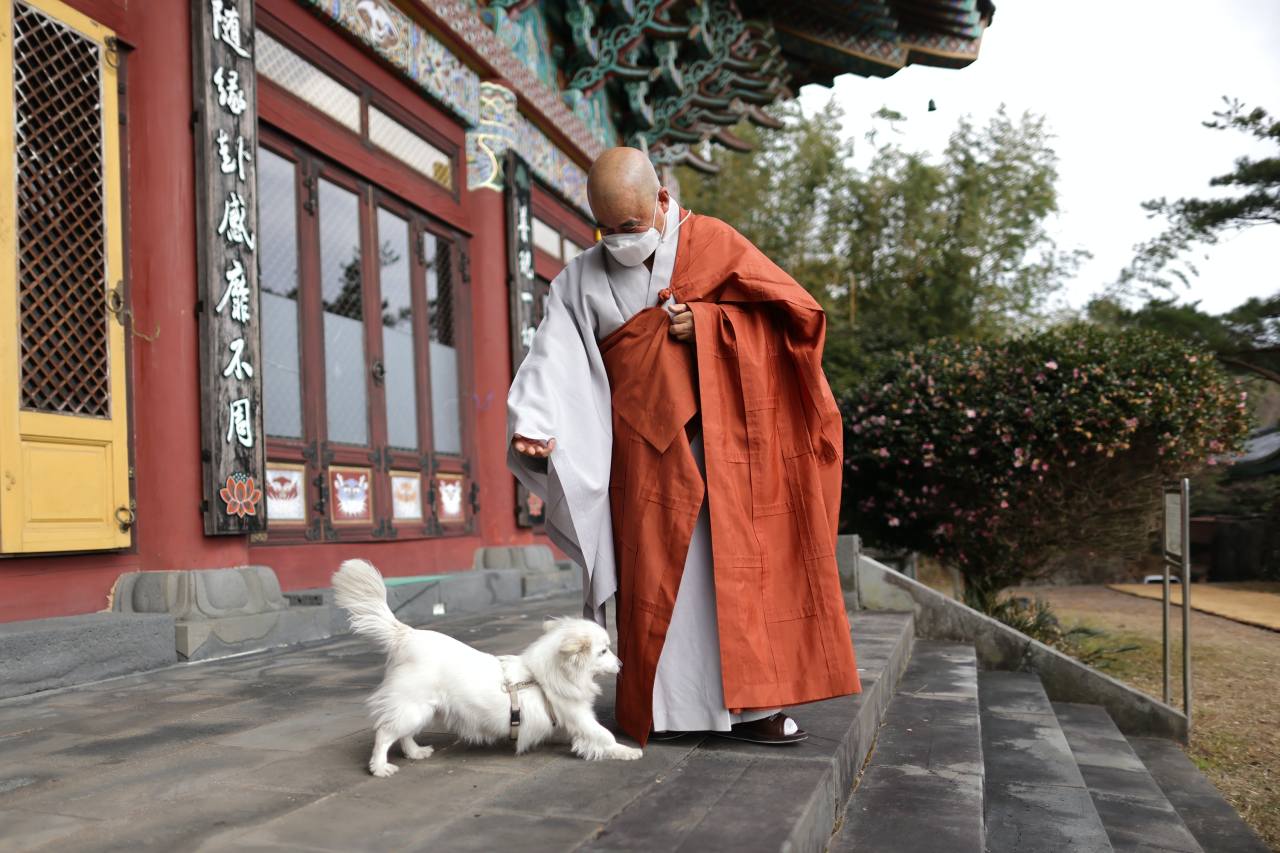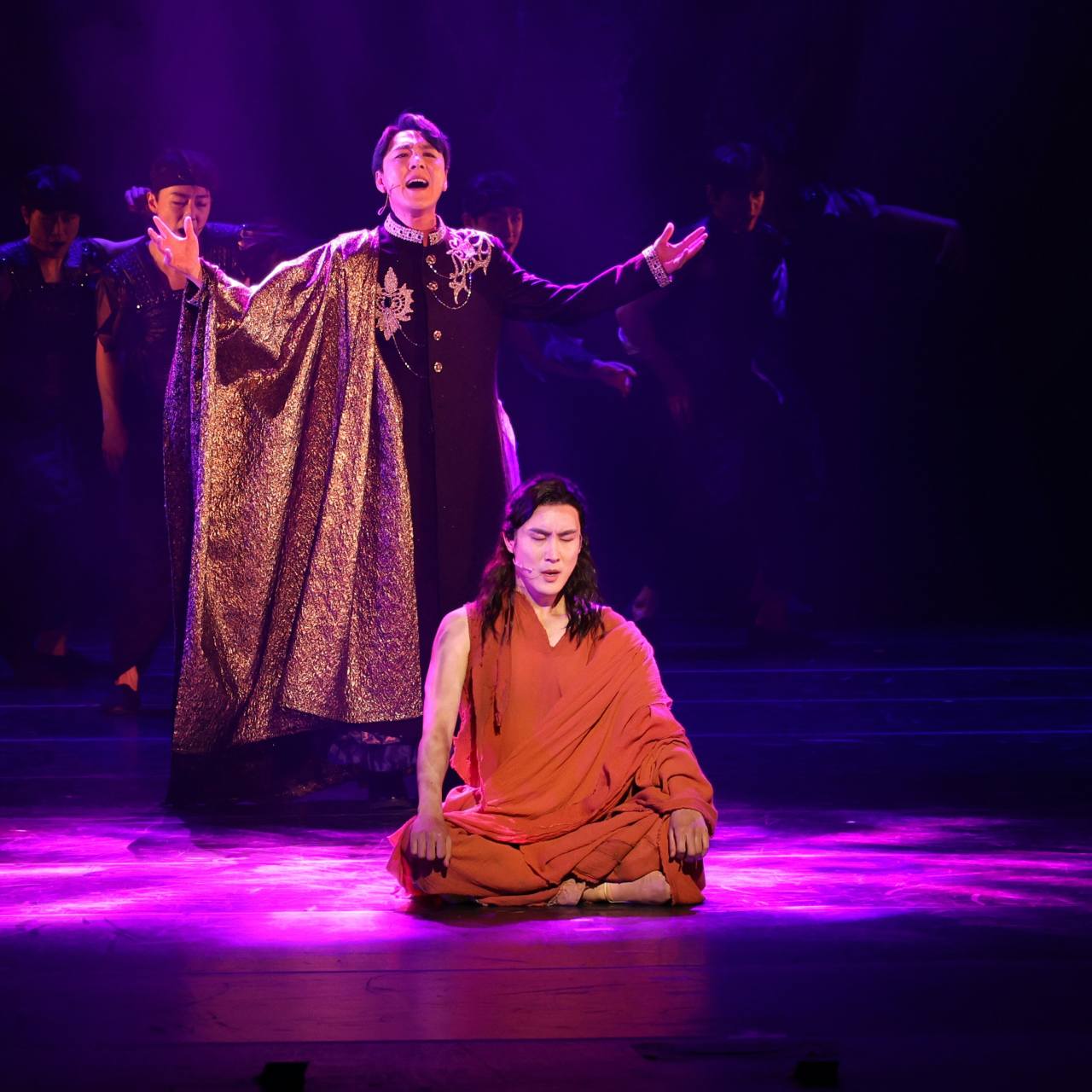
The Great Ven. Bopta, the top monk at the Eunhaesa temple, speaks at his residence in Yeongcheon, North Gyeongsang Province.Photo @ Hyungwon Kang
Koreans celebrate the birth of Siddhartha Gautama, better known in Korea as Shakyamuni Buddha, on Chopail, a public holiday on the eighth day of the fourth lunar month, which falls on May 8 this year.
Some of life’s questions for humanity have always been “Who am I?” and “Where am I going?”
In Korean Buddhism, Chamseon, which means participating in Seon meditation, the goal is to reach enlightenment.
“You must know who you are first, before you know where you are headed in life,” said the Great Ven. Bopta, the top monk at the Eunhaesa temple in Yeongcheon, North Gyeongsang Province, which was founded in the year 809.
“Enlightenment is the perfection of wisdom. When you’re enlightened, the state of nirvana becomes a state of joy and a feeling of eternal peace,” said Bopta, who said he first experienced reaching the so-called “happy place” in his 20s. “It was like the sun was rising. The world was a bright place, clear, full of joy, an eternal peace. It was a nirvana,” said Bopta.
Korean Buddhism teaches that by nature, we are born a Buddha, and the lifelong goal is to return to that natural state of being a Buddha -- to be freed from greed and obsessions, and escape from the burden of the cycle of reincarnation by becoming an enlightened one.
Chamseon, also known as the Seon meditation, is a unique Korean tradition, with many Great Monks having reached enlightenment in Korea’s 2,000-year Buddhism history.
There are people who reflect daily on their spiritual history, life memories, and unresolved issues. While not all choose to look inward to examine their life choices, for Chamseon practitioners, introspection is one of the possible paths to enlightenment and they take self-reflection to another level.
The goal of Chamseon is not to understand life’s complex questions but to be enlightened with an experience of our innermost self, called “bonseong,” a true natural state. “Everything else besides bonseong in life is just a series of phenomena,” said Bopta.

Great Ven. Haekook, one of the Great Monks in Korean Buddhism and a Chamseon master, is pictured with temple dog Bori at Namgukseonwon on Jeju Island.Photo © Hyungwon Kang
Unlike other religions, where practitioners seek help from the almighty God, a supreme deity or multiple gods, in Buddhism, everyone’s goal is to become a Buddha.
Buddha means the enlightened one, or awakened one. Siddhartha was the physical embodiment of the sage whose teachings led people from the pain of suffering and rebirth toward the path of enlightenment, and later became known as the Buddha.
One can reach the state of being enlightened to become a Buddha through studying Buddhist scriptures and teachings of Shakyamuni Buddha, or one can reach the enlightened bonseong, through the practice of Chamseon.
According to Chamseon master Great Ven. Haekook, one of the Great Monks in Korean Buddhism, our body is a like a little universe of its own, containing innumerable possibilities, having won against all kinds of odds -- from the way in which it’s conceived to the final shapes of our body and features, making us who we are.
Haekook says Chamseon is not knowledge to be learned, rather is experiencing being enlightened.
A person can be enlightened through the practice of Chamseon in one of three clearly articulated paths:
First, the Hwadu method, which is a practice in which Chamseon practitioners get to the bottom of an unsettled or unresolved subject in mind through breathing exercises.
Second, the Silent Zen meditation, which was popularized in the English-speaking world by Japanese Buddhists.
Third, by chanting, which at times is combined with meditation.

A scene from the musical “The Life of Siddhartha” depicts the life of Siddhartha Gautama, better known in Korea as Shakyamuni Buddha.Photo © Hyungwon Kang
Ven. Junggoong, one of the disciples of Haekook, has been practicing Chamseon for 20 years, getting up at 2:40 a.m. daily to start his Seon meditation at 3 a.m. which continues until bedtime at 9:40 p.m.
Junggoong says when you dig deep into Seon meditation, through long sustained breathing, “I feel my brain cells open up. Things I usually don’t remember come up. At the same time, I feel my own manipulation of facts, I mean I’m trying to cheat myself, there are things that I’m fooling myself. That’s when I call it out. ‘It’s you! Don’t move!’ That is ‘gyeonseong,’ a view of oneself removed from oneself.”
Gyeonseong, such as this subjective experience, may have something to do with self-rationalization and confirmation bias, which we all use to justify our actions as a form of self-preservation. In psychology, it is called cognitive dissonance, according to Korean American clinical psychologist Dr. Yangja Chung.
While most life experiences are subjective, being able to look back on our life experiences objectively from time to time always provides valuable insight.
“People think there’s no such thing as an objective view, but there never was an objective or subjective thing or a wall between them. Inside and outside can only be divided by a wall, but if there’s no wall, there’s no distinction between the inside and the outside,” said Haekook, who burned his fingers in reaching enlightenment.
“Enlightened means perfection of wisdom and to stay alert and awake in life,” said Bopta. “The path of the enlightenment can be excruciatingly painful, sitting desperately for hours and days until near death. At other times, awakening happens when you experience a physical shock.”
Bopta recalled one of his first moments of enlightenment when he was deployed to fight in the Vietnam War in his 20s, with eight months of military training under his belt. He was part of the reconnaissance team in the White Horse Division, the ROK Army 9th Infantry Division
“I was carrying a heavy rucksack weighing at least 30 kg with four additional hand grenades plus my weapons and ammo. On my first helicopter ride and of course, my first mission was jumping from a helicopter, as I was hesitating from jumping about 2 meters down to the ground -- in the middle of a jungle in Vietnam -- a US soldier kicked me off the helicopter yelling, ‘Son of a b----!’” he said.
“That’s when I had an enlightened moment. I did not feel the weight of my rucksack, landing softly on the ground on my feet, while bullets were flying everywhere,” said Bopta.
By Hyungwon Kang (
hyungwonkang@gmail.com)
---
Korean American photojournalist and columnist Hyungwon Kang is currently documenting Korean history and culture in images and words for future generations. -- Ed.



![[AtoZ into Korean mind] Humor in Korea: Navigating the line between what's funny and not](http://res.heraldm.com/phpwas/restmb_idxmake.php?idx=645&simg=/content/image/2024/04/22/20240422050642_0.jpg&u=)
![[Exclusive] Korean military set to ban iPhones over 'security' concerns](http://res.heraldm.com/phpwas/restmb_idxmake.php?idx=645&simg=/content/image/2024/04/23/20240423050599_0.jpg&u=20240423183955)



![[Graphic News] 77% of young Koreans still financially dependent](http://res.heraldm.com/phpwas/restmb_idxmake.php?idx=645&simg=/content/image/2024/04/22/20240422050762_0.gif&u=)